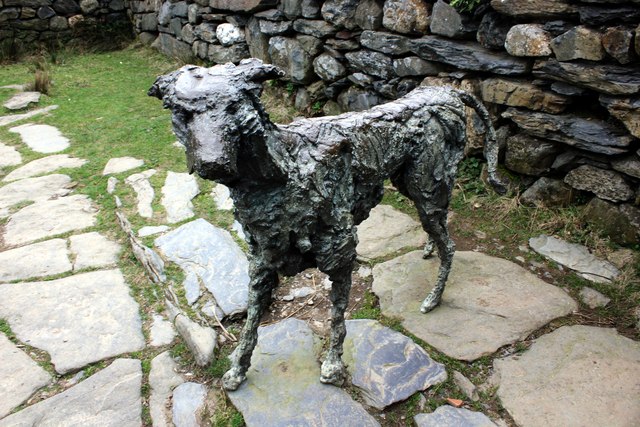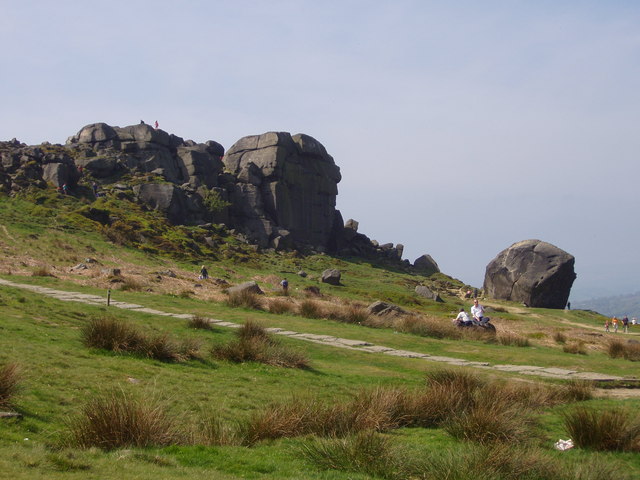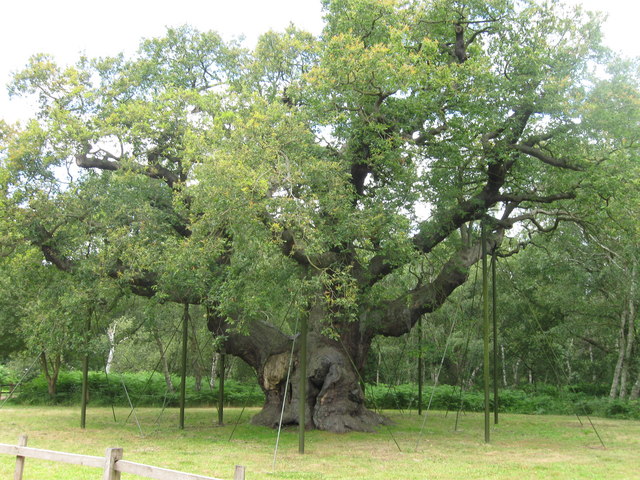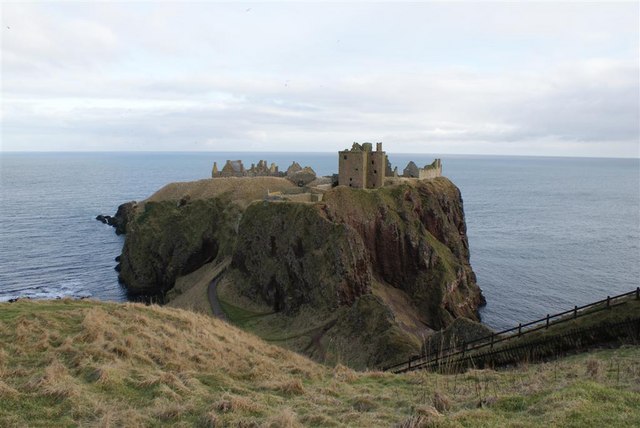Take a walk through myths, legends and stories
Britain is steeped in history, and with history also comes a few tall tales, myths and folklore. To celebrate the very real (and the not so real), we have decided to take a look at some of the locations around the UK that you can visit and learn of some wonderful stories to accompany the scenery. We’ve scoured the UK for some of the fantastic, interesting stories and the locations that you can visit to find them. We’re a land of giants, hounds, fairies, ghosts, wizards, witches and more, in fact you’ll probably find that any eerie, strange, odd looking place will have a full legendary story to go along with it. We’ve asked GO colleagues and customers and compiled a list of some of the favourites for you to try out.
1. Whitby Abbey & Dracula – Whitby, North Yorkshire

Whitby Abbey © Copyright Derek Harper
Probably one of the most famous story associations in the UK, is Dracula (and more specifically writer Bram Stoker’s) connection to the coastal town of Whitby. It’s said that on a visit to Whitby in 1890, Stoker took much inspiration for his book from the town, landscapes and stories of the area. It is believed he found the name ‘Dracula’ in a book from a library in the area, while the 199 steps and Whitby Abbey play an important part in the story. Dracula remains a huge part of any visit to Whitby today, with many coming from miles around to visit the ‘spiritual’ home of Dracula.
Take in this story with this walk: http://where2walk.co.uk/north_york_moors_coast/coastal_exploring/whitby-abbey-and-the-coast/
2. Cadair Idris, Snowdonia

Llyn Cau, Cadair Idris © Copyright Nigel Callaghan
A popular mountain in southern Snowdonia that comes with a whole host of stories attached to it. Its name derives from ‘Chair of Idris’, Idris according to Welsh legend was a giant warrior poet who created this seat to gaze upon the heavens. If a giant warrior poet wasn’t enough, some say Cadair Idris is the hunting ground of Gwyn ap Nudd, Lord of the Celtic Underworld ‘Annwn’ who is accompanied by his supernatural red-eared hounds while they herd people’s souls back to the underworld. Llyn Cau, the stunning lake shown in the image above, is said to be a bottomless lake that is home to a Welsh water dragon. The dragon once used to terrorise villagers until King Arthur captured it and dragged it up the mountain to imprison it in Llyn Cau. Cadair Idris is a stunning place, and one that is ripe with legends and tales, but one more to consider (if you’re thinking of staying on the mountain overnight) is that it’s said those who consider sleeping on its slopes will awake a madman, a poet – or not wake at all!
Take in this story with this walk: http://www.trekkingbritain.com/cadairidristheminfforddpath.htm
3. Devil’s Bridge, Kirkby Lonsdale, Cumbria

Devil's Bridge, Kirkby Lonsdale © Copyright Alexander P Kapp

Devil's Bridge, Kirkby Lonsdale © Copyright Alexander P Kapp
Legend has it that the Devil appeared to a woman where the bridge stands, offering to build a bridge in exchange for the first soul that crossed it. When the bridge was finished, the woman threw some bread over it and her dog chased it, thereby ‘outwitting’ the devil. Seems a bit cruel if you ask me, no wonder there are so many hell hound myths around the UK!
Take in this story with this walk: http://where2walk.co.uk/yorkshire_dales/riverside_walks/the-lune-valley-at-kirkby-lonsdale/
4. Robin Lythe Cave, Flamborough Head, East Yorkshire
An enchanting cave at Flamborough Head where tales of smugglers and ships meeting their end have existed for years. One such potential smuggler was Robin Lythe who is still said to haunt the cave as he rolls his barrel of cognac over the stones. At low tide, the 15m high cave is enough to put your imagination into overdrive. The area is also host to plenty of walks, so it’s certainly worth a visit to find out more about the legend of Robin Lythe.
Take in this story with this walk: http://walkingtheriding.eastriding.gov.uk/EasysiteWeb/getresource.axd?AssetID=38942&type=full&servicetype=Attachment
5. Betty Kenny Tree, Shining Cliff Woods, Derbyshire

Betty Kenny Tree - Shining Cliff Woods © Copyright Jerry Evans
It may not look like much now, but local legend has it that Betty Kenny and her husband Luke lived in the woods and often sought shade under this yew tree in the 1700’s. This is where they raised their 8 children, one of which was allegedly buried here. It’s claimed that the nursery rhyme ‘Rock-a-bye-Baby’ originated with Betty using one of the hollowed out tree boughs to rock her children to sleep. The tree was actually burnt by local children in the 1930’s. It was said to be 2,000 years old in 1909. The area is popular with downhill mountain bikers, there’s also the ‘Betty Kenny Walk’ which takes in the remains of the tree.
Take in this story with this walk: http://info.ambervalley.gov.uk/docarc/docviewer.aspx?docGuid=0b1d5213e1d9424b8de8547ea63e2f8c
6. Robert the Bruce’s Cave, Kirkpatrick Flemming

Robert the Bruce's cave © Copyright Stephen Charles
The legend of Robert the Bruce and the spider has a few potential locations, but the strongest candidate appears to be this cave in Dumfriesshire. It’s said that this small sandstone cave on the Cove Estate was the hiding place of Robert the Bruce in 1306 when he was trying to evade capture from Edward I after he was defeated. Living in the cave for 3 months, legend has it that Bruce watched a spider as it tried and tried to build it’s web, watching as it failed on numerous occasions, but climbed back up the wall to carry on. Bruce at his lowest took inspiration from the spider, he found it in himself to raise an army and would go on to win the famous battle of Bannockburn in 1314 where his claim to the Scottish thrown would be solidified.
Take in this story with this walk: http://scotlandoffthebeatentrack.blogspot.co.uk/2016/12/bruces-cave.html
7. Lud’s Church, Gradbach, Staffordshire

Lud's Church © Copyright Oliver Dixon
The first thing you’ll notice from the image above is that this isn’t a church. Lud’s Church is a chasm in the Roaches area of the Peak District that is steeped in mythology and legend, the only issue is – it’s not that easy to find. It’s a little off the beaten track, to say the least, but well worth it for the adventurous type. It can be found in Back Forest, it’s 100m long and 18m deep, overgrown and mossy which makes it look like an ancient jungle ruin. Lud’s Church is a ‘natural’ church, a place of worship provided by the earth and it’s thought that it gained its name from the Lollards that used to worship here with ‘Lud’ coming from Walter De Ludbank who was taken captive during one of their meetings. There are also tales that the likes of Robin Hood, Friar Tuck and Bonnie Prince Charlie had all used Lud’s Church as a hiding place at some point (though there doesn’t seem to be many places in this area of England that Robin Hood didn’t go).
Take in this story with this walk: http://www.theaa.com/walks/luds-church-and-the-roaches-420970
8. Sawney Bean’s Cave, Bennane Head, South Ayrshire

Sawney Bean's Cave © Copyright Mary and Angus Hogg
In one of the grimmest tales on this list, the legend of Sawney Bean and his incestuous cannibal is a tale in Ayrshire folklore. The story goes that Alexander ‘Sawney’ Bean was the head of a 48 member family who attacked single travellers and was at fault for the killing and eating of over 1,000 people. The family would emerge at night to drag their victims back to their cave home to kill and dismember them. One night the Bean’s met their match as a man who could hold his own fought back until others heard the commotion, spooking the family to running away. A search party was organised to find the heinous family, and on their capture, they were refused the right to a trial, and shortly thereafter – executed. While there’s no historical evidence to back up the execution (and so the existence of Sawney Bean), Cannibals are said to have existed in this area and so it adds an element of wonder to the whole story. This cave has actually been inhabited since then by a local known as Snib Scott until the 1970’s. If you see a stone with a plaque dedicated to Snib at the top of the cliff, you know you’re in the right place. As a warning, this cave is not easy to reach and impossible during high tide.
Take in this story with this walk: https://www.walkhighlands.co.uk/glasgow/ballantrae-lendalfoot.shtml
9. Gelert the Dog’s grave, Beddgelert, Gwynedd

Bronze Statue of Gelert at Beddgelert © Copyright Jeff Buck
The story of Gelert the dog is a real favourite among fans of the outdoors. Gelert was the favourite dog of Prince Llywelyn of Gwynedd. Llywelyn left his new born son with the family nurse as he headed out on a hunt. While the master was away the nurse and a servant chose to go for a walk, leaving the baby unprotected, meanwhile out on the hunt, Llywelyn had noticed that Gelert was no where to be found in the hunting party, he calls off the hunt and heads for home in hope his dog had returned there. As they arrived back home, Gelert ran out to greet his master, but the dog was covered in blood and wagging it’s tail. Thinking the worst, Llywelyn stormed into his home to find his baby’s cradle overturned, and the bed clothes covered in blood with no sign of his baby son. Llwelyn draws his sword and kills the dog, and as the dog dies he hears the cries of his baby, only to find his son behind the cradle unharmed next to a large dead wolf. Gelert had saved his son. Llwelyn was said to have never spoken again, burying his trusty dog and spending the rest of his days being able to hear his trusty friend’s final whimpers. The village of Beddgelert is said to get it’s name from the legend, where a bronze statue of Gelert stands to this day.
Take in this story with this walk: https://www.nationaltrust.org.uk/craflwyn-and-beddgelert/trails/gelerts-grave-walk-beddgelert
10. Wistman’s Wood, Dartmoor

Wistman's Wood © Copyright Rob Purvis
Dartmoor is a place with plenty of supernatural folklore, but one story that stands out is Wistman’s Wood. A stunning area of wood with moss-covered stones and twisted trees that is said to be haunted by a cloaked figure who hunts with his pack of hellhounds (why must they always be hellhounds? We need more dogs like Gelert). It’s thought the cloaked figure and their hounds hunt for the souls of anyone who dare enter the forest. Not a very nice chap really, is it any shock that Hound of the Baskervilles was set in Dartmoor?
Take in this story with this walk: http://www.countryfile.com/days-out/wistmans-wood-dartmoor
11. The Blue Men of Minch, Isle of Lewis

Heather, rocks and a view of the Minch © Copyright Peter Barr
Before their hit stage show, the Blue Man Group were said to have terrorised the North Minch, a strait between the north-west of the Highlands and the Isle of Lewis (Obviously we jest). The Blue Men of Minch (Also known as storm Kelpies) terrorised sailors, looking for men to drown and boats to sink in the area, while they slept the weather was fine, but they could cause a storm at will. If you stayed on their good side, you’d be granted easy access. The Blue men were known to help locals whereby in an exchange for ale poured into the sea, they would fertilise the beaches with seaweed. Some claims state that the only way to get the better of the Blue Men of Minch is to get the last word in a rhyming trade-off.
Take in this story with this walk: http://www.ramblers.org.uk/news/walk-magazine/current-issue/2015/august/autumn-2015/rrid-hebridean-way.aspx
12. The Big Grey Man of Ben Macdhui

Southern slopes of Ben Macdui drop away © Copyright Alan Reid
Ben Macdhui is the biggest mountain in the Cairngorms, and the second biggest in the UK. Locally there is a tale of a big grey man living in the Cairngorm mountains. Unlike many of these legends, there isn’t much of an elaborate backstory to who the big grey man is (Some believe him to be the spirit of the mountain), instead there are simple accounts of having seen or sensed his presence on trips up the mountain. There are a few theories about what people have seen up there, one of which (and if you don’t want to ruin the magic, turn away now) is that people are simply seeing a ‘Brocken spectre’ which is a phenomenon which only occurs when there is an inversion (gaps in the clouds) which allow the person to be able to see their own shadow cast onto the cloud in front of them, it would, therefore, create a large grey figure, and in some conditions would appear with a circular rainbow around it. Though I think I prefer the idea of the manifestation of the spirit of the mountain.
Take in this story with this walk: https://www.walkhighlands.co.uk/cairngorms/macdui-cairngorm.shtml
13. Herne the Hunter, Windsor Forest, Berkshire

Windsor Forest © Copyright Alan Hunt
Herne the Hunter is a ghost associated with Windsor Forest. He’s said to wear antlers, ride a horse, scare cattle and rattle chains, some versions of his legend state that he was a keeper in the forest who committed an offence and rather face the fall from grace hung himself to save himself the shame. While the fabled Herne’s Oak where he was hanged no longer exists, the hauntings of Herne seem to spread throughout Windsor Park.
Take in this story with this walk: http://www.theaa.com/walks/windsors-great-park-420098
14. The Hermitage near Falling Foss, North York Moors

The Hermitage nr Falling Foss © Copyright Derek Harper
The Hermitage (as it’s known locally) is a cave carved out of a boulder which is said to date back to 1790 and carved by a hermit called George Chubb. On top of his boulder home sit two ‘wishing’ chairs, where it’s said if you make a wish in one chair, you then sit in the other chair to make it from true. The Hermitage is near by to Falling Foss, a fantastic 30ft waterfall. A great little story for the family to explore.
Take in this story with this walk: http://www.northyorkmoors.org.uk/visiting/enjoy-outdoors/walking/our-walks/walking-routes/may-beck-and-falling-foss
15. Myfanway of Dinas Bran, Llangollen

Castell Dinas Bran © Copyright Nigel Williams
Long before dating apps, men would come from miles around to court a beautiful woman. Myfanway was the most beautiful woman in Powys, but she was incredibly vein and despite many trying, she had no interest in them if they could not compose a song or poem that truly reflected how beautiful she felt she was. Only one man had the talent, a poor bard from the valley beneath the castle, one day he plucks up the courage to try and woo Myfanway, his song reflects her beauty exactly how she’d like and she cannot look at another man, the young man believed he’d hit the jackpot, he’d won her over… Until a richer, more handsome man came along, he was kicked to the curb, left to roam the Dyfrdwy Forest composing a poem for his lost love. It’s said that this story came long before the term ‘plenty more fish in the sea’.
Take in this story with this walk: http://www.countryfile.com/days-out/castell-dinas-bran-llangollen
16. Cow and Calf Rock, Ilkley Moor

Cow and Calf Rock, Ilkley © Copyright Matt Baines
The Cow and Calf rocks are high up on Ilkley Moor, the outcrop and boulder so named because one is large and the other is smaller and sat nearby, like a cow & calf (I know, it’s a bit of a stretch). According to local legend, the calf was split away from the cow when the giant Rombold was fleeing his angry wife, he stepped on the rock as he was leaping over the moor. While giving chase it’s said that Rombold’s wife dropped the stones she was holding in her skirt, which created the ‘skirtful of stones’ rock formation. Don’t worry the area is far better for walks and climbing than it is at resembling a cow.
Take in this story with this walk: http://where2walk.co.uk/yorkshire_dales/village_walks/ilkley-moor-bahtat/
17. Major Oak, Sherwood Forest, Nottinghamshire

The Major Oak © Copyright Alex McGregor
We couldn’t create a list of storied locations to visit without including something from Robin Hood. The Major Oak is said to be where Robin Hood and his merry men slept when not out robbing the rich and giving to the poor. The tree is said to be between 800-1000 years old. You’ll find plenty of legends and tales of Robin Hood in Sherwood Forest, so it’s an ideal visit for families.
Take in this story with this walk: http://www.walkingbritain.co.uk/walk-2429-introduction (You can also head straight to Major Oak near the Sherwood Forest visitor centre, if with children)
18. Cadbury Castle, Somerset

Cadbury Castle - Joe D
We all know the stories of King Arthur and his Knights of the Round Table, Cadbury Castle in Somerset (sadly not made of chocolate like it’s name may suggest) used to be known as Camalet and is said to be the most likely place where King Arthur’s court at Camelot was based.
Take in this story with this walk: http://www.theaa.com/walks/cadbury-castle-as-camelot-420949
19. Tintagel, Cornwall

Tintagel Castle © Copyright David Cumberland
Speaking of King Arthur, another location steeped in Arthurian legend is the stunning Tintagel castle. Legends has it that Arthur was actually conceived at Tintagel, which gained momentum the more books were written. This claim is a bit controversial and has been argued back and forth over time, but the area still embraces it’s connection to King Arthur and as such, it makes it a fantastic family day out. Tintagel not only features the famous castle, but also ‘Merlins Cave’. There’s actually a footpath called Arthur’s Way which goes from Tintagel, to the above Cadbury Castle.
Take in this story with this walk: http://www.southwestcoastpath.org.uk/walksdb/198/
20. Giants Causeway, Northern Ireland

Giants Causeway © Copyright alphageek
Arguably the most famous attraction in Northern Ireland, when you visit you’ll be met with the scientific reason for the rock formation and the slightly more wonderful story that goes alongside it. The story goes that a local giant named Finn McCool (great name) was having a bit of trouble with a Scottish giant across the water who was threatening Ireland. This didn’t sit well with McCool and so he started ripping up bits of the Antrim coastline, throwing them into the water to create a path to head over to Scotland to give his foe a piece of his mind. Well, that was the plan, when Finn was storming over his path he realised just how big the Scottish giant was and made a hasty retreat. The Scottish giant gave chase, but Finn McCool’s quick thinking wife had disguised him as a baby, the Scottish giant saw the large baby and thought that it probably wasn’t wise to stick around and fight a man that could produce a baby so large.
Take in this story with this walk: http://www.walkni.com/walks/398/giant-s-causeway/
21. Ossian’s Cave, Glen Coe

Ossian's Cave © Copyright Kim Traynor
Among the famous three sisters mountains in Glen Coe you will find an 8ft cave opening in the rocks known as Ossian’s Cave. Ossian is the son of a famous Irish warrior called Fionn Mac Cumhail (also known as Finn McCool, yes the same Finn McCool that created the Giant’s Causeway) and this cave was said to be Ossian’s birthplace. Ossian’s mother Sadbh spurned the interest of a druid, and as is usually the case, the druid didn’t take rejection particularly well and turned Sadbh into a deer. While Fionn Mac Cumhail was hunting in the area, he found his hounds wouldn’t bring down a specific deer. He called off the dogs and approached the deer, only to see it wasn’t a deer at all, but a beautiful woman. The two fell in love, and soon Sadbh fell pregnant. The druid was not a fan of this happy ending, and so turned Sadbh back into a deer, and she scurried off into the wild, leaving Fionn to return to Ireland alone and never see Sadbh again. Sadbh found safety in a cave where she gave birth to Ossian. Fionn would meet his son for the first time years later in the mountains or Ireland. It was found that his son had deer like qualities, he could leap further than anyone and run light-footed through the forests, so Fionn welcomed him into his gang of warriors. It’s not easy to actually reach Ossian’s cave and is best viewed from the glen below, however, it’s certainly worth a visit to this enchanted bit of land.
Take in this story with this walk: http://www.go4awalk.com/walks/walk-search/walk.php?walk=h162
22. Dunnottar Castle, Stonehaven

Dunnottar Castle © Copyright Karen Vernon
There are plenty of stories surrounding what is arguably one of Scotland’s most spectacular looking castles. The castle has not only played home to William Wallace, Mary Queen of Scots and Marquise of Montrose, for the little ones it was also the castle that inspired Merida’s castle in Disney’s ‘Brave’.
Take in this story with this walk: https://www.walkhighlands.co.uk/aberdeenshire/dunnottar-castle.shtml
23. Llyn y Fan Fach, Brecon Beacons, Cartmarthenshire

Llyn y Fan Fach © Copyright Jeremy Bolwell
This lake in Brecon Beacons National Park comes with a tale known as ‘Lady of the Lake’. A local man attempted to woo a woman he found sitting beside the lake, after his attempts she agreed to marry him under the condition that he must treat her well. If he was to hit her three times, she would have to return to the lake. The man agreed and took the girl to the nearby village of Myffai where they lived as husband and wife. At the Christening of their first child, the man was overjoyed but the girl from the lake cried as she believed the child would be harmed by the sun. The man gave his wife a ‘tap’ to bring her to her senses. At a funeral, the girl cried as she believed the bridegroom would die soon, again her husband gave her a knock to make her see sense. The bridegroom did indeed die, and at the funeral, the girl laughed as she was happy for him that his suffering was over. Embarrassed, the man gave his wife a tap once more to make her see sense. She’d been hit 3 times and instantly went back to the lake leaving her husband heartbroken. The man was left to raise their 3 sons alone. As the sons grew older, it became clear they had inherited some of their mother’s magical abilities, and rather than use this for bad, or to become warriors, they became the first in a long line of powerful healers. The trio used natural products to create early versions of medicine and became known as the Physicians of Myddfai.
Take in this story with this walk: http://www.discovercarmarthenshire.com/active/active_images/llyn-y-fan.pdf
Of course there are only 23 of the many thousands of myths, legends, locations and stories that can be found in the outdoors around the UK. What are your favourites? Let us know in the comments below.

